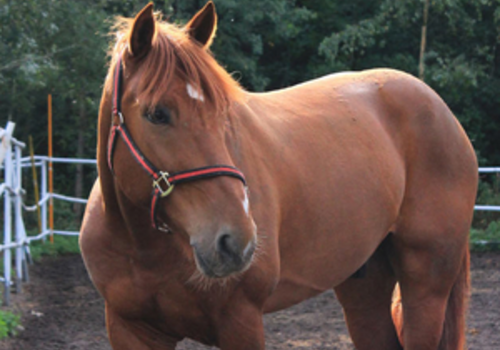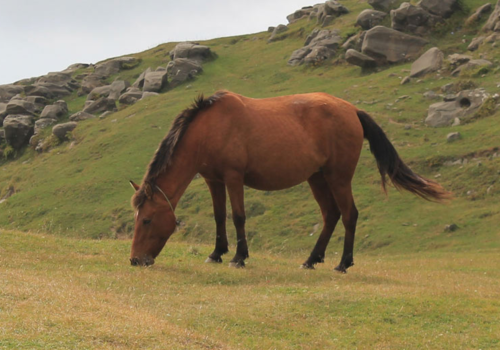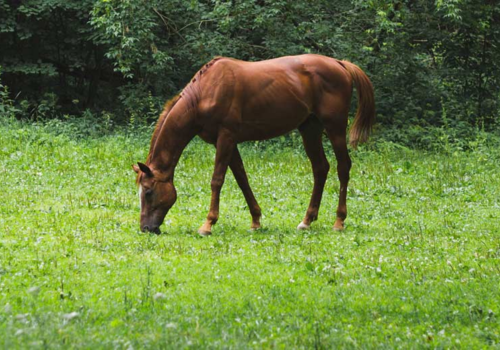Laminitis is one of the most common causes of lameness and disability in horses and ponies. It's a disease that affects the feet of hooved animals and it’s characterised by inflammation of the digital laminae of the hoof. Severe cases with outwardly visibly clinical signs are known by the colloquial term 'founder'.
If you suspect that your horse may have developed laminitis, seek advice from your vet immediately. Early treatment is often critical and can dramatically reduce the likelihood of “founder”.
What are the symptoms of laminitis?
If your horse has laminitis, or you know they have suffered with it previously, there are a number of short-term and long-term symptoms to look out for:
Initial symptoms of laminitis
- Laminitis can impact all four feet of your horse but it is common for forelimbs to be more severely affected. Try to pay special attention to how your horse is holding itself on its forelimbs.
- Because of the pain of putting weight on the affected limbs, your horse may show a reluctance to move around as they normally do. It’s not unusual to see your horse rocking back and forth to try and take the weight off of its forelimbs.
- Your horse will be very hesitant to be physically handled and they will especially not want you to pick up any individual forelimbs. The extra pressure on their other limbs will prove too painful.
- Gently feel the soft tissue around the top of your horse’s hoof as it will often feel very warm due to the inflammation.
- An unusually strong and rapid pulse. If you don’t know how to take your horse’s pulse but are concerned about laminitis, ask your vet to come and take their pulse as it can be a very helpful indicator.
- When given the option, your horse will choose to lay down to take the weight off of its limbs and rest.
Chronic symptoms of laminitis
- You may notice rings on the surface of your horse’s hooves which mark previous episodes of laminitis.
- The hoof shape will change and you’ll notice longer toes.
- A bulge in the sole is where the pedal bone has rotated within the hoof.
How do horses develop laminitis?
There are a number of ways horses can develop laminitis. One of the most common is over-feeding ponies, especially in the spring season when it has rained. This is because the carbohydrate content increases in the grass after rain which causes metabolic changes when ingested. This metabolic change alters blood flow to the laminae of the hoof.
It’s important not to over-feed your horse at any age though, not just when they’re ponies, as obesity is another common factor in horses that develop laminitis.
Overworking and trauma can also contribute to laminitis, especially in unshod horses working on hard ground.
Some causes involve pre-existing conditions, as horses with septicemia, a bloodstream infection, are also prone to laminitis.
Can laminitis in horses be cured?
Laminitis is a very serious condition for horses that can, unfortunately, prove fatal. It’s a very painful condition for horses and once they have suffered through an episode of laminitis, they are left more prone to future bouts.
While it can be treated and managed, it can’t be cured. This is why it’s really important to focus on preventing laminitis where possible or choosing the right grass seed for laminitic horses.
What is the best paddock grass seed for horses with laminitis?
If your horse is suffering from laminitis, has suffered from it previously, or is in an at-risk group, there are some management tools you can put into place. One is to ensure they have the right diet by planting the right paddock grass seed. The right grass seed mixture will ensure your horse gets all of the nutrients they need.
Horses with laminitis need a diet that has a reduced sugar content, both Sucrose and Fructan sugar. It’s therefore advisable to reseed any existing grazing areas with a paddock grass mixture that has been specially designed for a laminitis-friendly diet.
We would recommend our Choice Horse & Pony Paddock mixture as it is free of grasses such as ryegrass, which are known for their high sugar content. The grass species in this mixture are also low-maintenance and don’t require excess fertilising to maintain a healthy sward - which can help to keep sugar content more consistent throughout the year.
We have a handy guide on reseeding and overseeding your paddock which you may also find useful.
Another option is our Triple 'H' Paddock Grass Seed Without Ryegrass, the H’s stand for Horse, Health & Herb. As well as a mixture of healthy grasses, this mixture is enriched with herbs to improve palatability and trace element intake.
In order to reduce intake further, strip grazing can be used by dividing large paddocks into smaller strips using suitable fencing. This also allows areas to rest to avoid overgrazing and can be used to produce a hay cut if necessary.
What can I do to prevent laminitis in my horse?
As we’ve discussed, overfeeding your horse can be a major contributor to laminitis. This is why we’d recommend using our paddock grass mixtures. We have a range of mixtures, all with different nutrient makeups, so you can choose a mixture that suits your horse’s age and activity level.
During the wetter spring months, be careful about how much access your horse is given to lush pasture because of the increased carbohydrate content in the grass after rain. Find out more about seasonal care in our yearly horse paddock care guide.
Ensure your horse receives regular hoof care from a well-trusted farrier and keep regular appointments with your horse veterinarian so that early signs won’t be missed.
What should I do if I think my horse has laminitis?
Contact a veterinarian immediately and follow all of their advice closely. The earlier you can treat laminitis, the quicker your horse will feel better and the chances of it developing again can be lowered.
You can take some immediate steps to improve your horse’s comfort though. If you suspect overfeeding is the cause, make sure your horse doesn’t have free access to food. They’ll need to be stabled, and do this in deep shavings so they have the depth to dig their hooves in. This will help reduce pressure on their hooves but you’ll need to be vigilant for any build-up of sand or shavings in their hooves.
It’s also important to ensure they’re still able to socialise. Horses are very sociable animals so it will only be a more difficult and frustrating illness for them if they aren’t able to interact with other horses. Laminitis isn’t contagious so you don’t need to worry about it being spread throughout the stable. However, it is important if one horse has laminitis to keep an eye on all your horses. This is because laminitis is often caused by lifestyle and your horses will have similar grazing and feeding habits so if one horse is at risk of laminitis, they all may be.
----------------------
Have a question about choosing the right grass seed for horses prone to laminitis? Get in touch with our friendly team of experts, who are always on hand to help.


